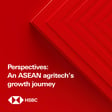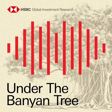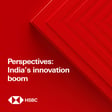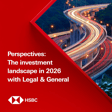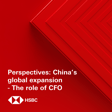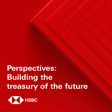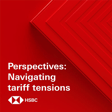Become a Creator today!Start creating today - Share your story with the world!
Start for free
00:00:00
00:00:01

Under the Banyan Tree - Busting the myths on Asian supply chains
Fred Neumann and Herald van der Linde are in myth-busting mode this week, debunking three widely held beliefs around the shifting landscape of Asian supply chains. Disclaimer: https://www.research.hsbc.com/R/61/FlFg9wK Stay connected and access free to view reports and videos from HSBC Global Research follow us on LinkedIn https://www.linkedin.com/feed/hashtag/hsbcresearch/ or click here: https://www.gbm.hsbc.com/insights/global-research.
Hosted on Acast. See acast.com/privacy for more information.
Transcript
Introduction to HSBC Global Viewpoint
00:00:02
Speaker
Welcome to HSBC Global Viewpoint, the podcast series that brings together business leaders and industry experts to explore the latest global insights, trends, and opportunities.
00:00:13
Speaker
Make sure you're subscribed to stay up to date with new episodes.
00:00:16
Speaker
Thanks for listening.
00:00:17
Speaker
And now onto today's show.
00:00:24
Speaker
This is a podcast from HSBC Global Research, available on Apple Podcasts and Spotify.
00:00:30
Speaker
However you're listening, analyst notifications, disclosures and disclaimers must be viewed on the link attached to your media player.
Shifting Supply Chains in Asia
00:00:46
Speaker
Hello and welcome to Under the Banyan Tree, your weekly one-stop shop for putting Asian markets and economics in context.
00:00:52
Speaker
I'm Fred Newman, Chief Asia Economist here at HSBC.
00:00:55
Speaker
And I'm Harold van der Linde, Head of Asian Equity Strategy also here at HSBC.
00:00:59
Speaker
We're in myth-buster mode today looking at supply chains across the region.
00:01:03
Speaker
We know they're shifting, but what kind of companies are behind this?
00:01:06
Speaker
Where is production moving to?
00:01:08
Speaker
And which economies actually benefit?
00:01:10
Speaker
Plus, the big question on the world's manufacturing giant, is China still the production behemoth it used to be now that Asian supply chains are becoming more spread out?
00:01:19
Speaker
Answers to all those questions and more coming up under the Banyan tree.
Myths About Supply Chain Movements
00:01:35
Speaker
Fred, over the last two, three years, we've been talking a lot about movements in supply chains in Asia, right?
00:01:42
Speaker
It's a big economic theme.
00:01:43
Speaker
It's a big, to a certain extent, a theme in the equity universe as well.
00:01:48
Speaker
When I passed your desk, I heard you talking with one of your colleagues about the three myths in supply chain movements.
00:01:56
Speaker
What are these three myths?
00:01:57
Speaker
What is the biggest myth?
00:01:58
Speaker
Let's start with that one.
00:01:59
Speaker
When it comes to the understanding of shifts in supply chains across Asia.
00:02:04
Speaker
Well, in the recent years, it's been a big talking point, right?
00:02:08
Speaker
Looking at supply chain diversification, China plus one strategies, this idea that supply chains are coming out of China, moving into other parts of the world.
00:02:18
Speaker
And there's something to that, but the stories are a little bit distorted.
00:02:22
Speaker
So there are kind of three myths that we call it around this.
00:02:26
Speaker
And the first one is
00:02:27
Speaker
It's really that it's a limited scope in terms of geography to where these supply chains are actually being moved to.
00:02:36
Speaker
So in Asia, we have big beneficiaries in Vietnam.
00:02:39
Speaker
That's a very well-known story.
00:02:40
Speaker
Malaysia, for example.
00:02:41
Speaker
And then you have further... Malaysia is a semiconductor.
00:02:44
Speaker
semiconductors, electronics, and then you have Mexico outside of this region.
00:02:49
Speaker
But this is primarily it.
00:02:51
Speaker
There's a little bit going into Bangladesh, there's a little bit going into Thailand, there's a tiny bit going into maybe Indonesia, a bit into India, but that's fairly limited.
00:03:01
Speaker
So the big beneficiaries of this particular move are really just three, four economies.
00:03:07
Speaker
It's not that if
00:03:08
Speaker
all of the rest of the region is really benefiting from this.
00:03:12
Speaker
So that's limited scope.
Tech Influence in India and Vietnam
00:03:13
Speaker
But aren't there quite a few tech companies going to India, for example?
00:03:16
Speaker
Or we've talked about the EV supply chain moving into Indonesia.
00:03:21
Speaker
There's some tech going into India, but part of this is to produce for the domestic market rather than necessarily for global supply chains.
00:03:29
Speaker
And the other thing is that it's not enough in terms of quality
00:03:33
Speaker
quantity to really make a big difference for the Indian economy overall.
00:03:37
Speaker
It's such a large economy.
00:03:38
Speaker
That's the issue, right?
00:03:39
Speaker
You're talking about supply chains, but actually they're a small part of the overall pie.
Chinese Companies' Global Investments
00:03:43
Speaker
Yeah.
00:03:43
Speaker
And so at the margin, it helps.
00:03:44
Speaker
But really, if you think about forecasting Indian growth, you're looking at what's the service sector doing, what's the agricultural sector doing, what's consumption doing.
00:03:52
Speaker
But not
00:03:52
Speaker
How many supply chains are coming in?
00:03:53
Speaker
Not looking at certain electronics components.
00:03:56
Speaker
Whereas if you look at Vietnam, for example, we have so much investment going in there that that really drives overall investment trends within the economy.
00:04:06
Speaker
So it's a different ballgame.
00:04:07
Speaker
Isn't it like Samsung exports or tech exports are like 80% of...
00:04:11
Speaker
of Vietnamese exports or something?
00:04:13
Speaker
A huge number, yeah.
00:04:14
Speaker
It depends which measures you use, but electronics themselves, certainly a big, big part of Vietnamese exports.
00:04:23
Speaker
Vietnamese exports actually are roughly 100% of GDP.
00:04:27
Speaker
So it shows how important that is.
00:04:30
Speaker
How relevant that is.
00:04:31
Speaker
And so you get a few more factories in there, it immediately makes a big difference for GDP.
00:04:36
Speaker
So limited scope...
00:04:37
Speaker
Yeah, that's the first myth.
00:04:38
Speaker
It's the first myth.
00:04:39
Speaker
It is not as big as we think it is, with the exception of some countries, right?
00:04:44
Speaker
What is then the second myth?
00:04:46
Speaker
What is the second mistake that we make if we think about this?
00:04:48
Speaker
So the second myth is that it's just Western companies that are fleeing China and moving elsewhere.
00:04:53
Speaker
But actually, if you look closely, it's a lot of Chinese companies who are moving investment in China.
00:04:58
Speaker
into other economies and that's a very important message here, partly because many Western firms are staying in China to supply the domestic market, so they're not leaving China.
00:05:10
Speaker
The other thing is that because it's Chinese companies that are moving to Vietnam or Mexico or Malaysia, they often use Chinese components, right?
00:05:19
Speaker
So actually the connectivity therefore between the Chinese economy and these economies is increasing because
00:05:26
Speaker
we're not really cutting out China.
00:05:28
Speaker
We're just adding, we're moving final assembly to these markets rather than kind of getting rid of all Chinese components.
00:05:36
Speaker
And so from that perspective, the fact that Chinese companies are doing that increases the connectivity between these economies and mainland China.
00:05:45
Speaker
And so the second myth is therefore, it is a lot of Chinese companies are doing that.
00:05:50
Speaker
And it's of course in a lot of industries in China, there's oversupply or there's too many producers of, for example, EVs, right, electric vehicles.
00:05:57
Speaker
So you see them moving out and they probably struggle with the US.
00:06:02
Speaker
Europe is maybe difficult to penetrate as well, very established place there.
00:06:07
Speaker
So then, yeah, you look at Asia, I guess Indonesia is a large market, India is a large market, but might also be difficult for them to get in, right?
00:06:13
Speaker
So...
00:06:14
Speaker
ASEAN would be a major sort of focus for them, I guess.
00:06:17
Speaker
ASEAN is huge, right?
00:06:18
Speaker
So the amount of foreign investment, particularly manufacturing investment, going from China into Southeast Asia is off the charts.
00:06:25
Speaker
It's growing very, very rapidly.
00:06:26
Speaker
The internet companies are also quite active, you know, yeah.
00:06:28
Speaker
Yes, yeah.
00:06:29
Speaker
There are actually sort of three drivers if you think about why Chinese companies are investing in Southeast Asia or other emerging markets.
00:06:36
Speaker
One of them clearly is because...
00:06:38
Speaker
Domestic demand is weak.
00:06:39
Speaker
They're trying to get a foothold in other markets.
00:06:41
Speaker
It's what you just described, right?
00:06:43
Speaker
So if the internet companies or the EV companies, for example, want to sell the products into local markets.
00:06:49
Speaker
In ASEAN, for example, 500 million consumers, that's a large market.
00:06:52
Speaker
Latin America fits in there, particularly if the European-US markets are becoming more closed and they're looking into emerging markets.
00:07:00
Speaker
That's why you see that flow of investment.
00:07:03
Speaker
The second one is that you have rising labor costs actually in China relative to these markets, right?
00:07:09
Speaker
And so it makes sense to shift a very low-end part of the production into these economies, but retaining the higher-end stuff in China.
00:07:19
Speaker
And so that's just China using Southeast Asia just as the U.S. used China many years ago as a kind of...
00:07:26
Speaker
Finding a lower wage area, right?
00:07:29
Speaker
So that's a second area.
00:07:31
Speaker
And then there's a third one, and that is that there are increasing distortions in terms of tariffs and trade restrictions in the global economy.
00:07:40
Speaker
And so by moving production to different areas, you can take advantage of different tariff regimes.
00:07:47
Speaker
And so there's a distortive element of trade restrictions that are coming in.
00:07:52
Speaker
Of course, US-China tensions, economic tensions have led to some of these investment flows.
00:07:57
Speaker
But there are other reasons as well.
00:08:00
Speaker
There's tariffs going up across the world, trade restrictions, and that leads multinational companies, including Chinese, to move production around just to optimize the tariff and trade strategy.
00:08:12
Speaker
And that's the third big driver of why Chinese companies are part of this investment surge into Southeast Asia, for example.
00:08:21
Speaker
Good.
China's Global Manufacturing Role
00:08:22
Speaker
Now, Fred, we've spoken about the first and the second myths.
00:08:24
Speaker
I propose we take a quick break here, and then we go look at the third myth and maybe the implication for markets as well.
00:08:30
Speaker
Sounds good.
00:08:41
Speaker
So Fred, we're talking about the three key myths that you've identified when it comes to supply chain movements across Asia.
00:08:48
Speaker
So we try to get a better understanding of it.
00:08:50
Speaker
The first myth that you mentioned was it's actually more limited in scope than what most people think it is.
00:08:55
Speaker
It's big for some countries, but for most countries, it's not as big as you think it is.
00:08:59
Speaker
You don't make changes in your GDP forecast necessarily just on the back of this.
00:09:05
Speaker
The second one is that a lot of people think this is global firms, non-Chinese firms, let's put it like that, that say, oh, I don't want to put all my eggs in one basket so I go somewhere else.
00:09:15
Speaker
Actually, it's a lot of Chinese companies that, for example, try to penetrate new consumer markets or find cheaper production facilities, in particular in ASEAN.
00:09:25
Speaker
But there's a third myth.
00:09:27
Speaker
What is that one?
00:09:29
Speaker
The third myth kind of comes really from the first two, and that is that actually this move of moving supply chains out of China, quote unquote, is actually not reducing the importance of China for the global economy.
00:09:44
Speaker
If anything, actually, the centrality of China for the global manufacturing sector is actually increased partly as a result of this move.
00:09:54
Speaker
And the way it works is that, yes, we're moving some of the final assembly to Mexico, to Vietnam, to Malaysia, but these factories are using Chinese components for the production.
00:10:07
Speaker
And so they still rely on China.
00:10:10
Speaker
In fact, on some measures, they rely increasingly on China rather than on other economies for the components.
00:10:16
Speaker
And so
00:10:17
Speaker
We can measure this and say, well, China's exports as a share of global exports may have come down slightly.
00:10:25
Speaker
And then people say, oh, China's losing market share.
00:10:28
Speaker
But if you look qualitatively, actually, the types of goods we buy from China are becoming more central to the manufacturing process.
00:10:37
Speaker
And therefore, China's importance to the global economy keeps on rising because China is no longer a producer of cheap assembly of products.
00:10:45
Speaker
It's not plastic bath ducts anymore, but it's electric vehicles now, right?
00:10:50
Speaker
It's electric vehicles.
00:10:51
Speaker
It's much more sophisticated.
00:10:52
Speaker
And actually, a lot of this is in the industrial sector.
00:10:55
Speaker
It is specific components that go into machinery that the Chinese produce.
00:10:59
Speaker
It's not sort of your plastic toys or plastic bottles, etc.
00:11:03
Speaker
from 10, 15 years ago.
00:11:04
Speaker
And that means that really China is enormously important for manufacturing.
00:11:09
Speaker
global manufacturing supply chains and that centrality is increasing, it's not declining.
00:11:13
Speaker
And so I think that's the third myth.
00:11:15
Speaker
And so putting that together, China is just a behemoth when it comes to manufacturing output.
00:11:22
Speaker
It's the largest manufacturer in the world.
00:11:24
Speaker
That's exactly when I started to look at this as well, maybe five years ago.
00:11:32
Speaker
I went to see some people at a university here in Hong Kong who've done economic geographers, who've done work on movements in supply chains, much more from a theoretical point of view.
00:11:41
Speaker
And that's exactly what they told me.
00:11:43
Speaker
They said it's such a behemoth and people want to sell their product there.
00:11:47
Speaker
And you've got these clustering facts that companies and industries can't just easily move.
00:11:52
Speaker
It's not sometimes we're very simple, right?
00:11:54
Speaker
We think, well, close the factory and build it up in Vietnam and go there.
00:11:57
Speaker
But you need the plastics.
00:11:58
Speaker
You need to...
00:11:59
Speaker
components you need everything else.
00:12:00
Speaker
It's a very slow process.
00:12:02
Speaker
Size matters in manufacturing and that's because you have so many specialized suppliers and the larger your sector is the more specialized suppliers you have that can actually improve their very specific products and so that
00:12:17
Speaker
That makes supply chains much more sticky.
00:12:21
Speaker
It gives you a competitive advantage.
00:12:22
Speaker
And of course, we can overlay this with a fairly weak currency of the past year with the absence of inflation, with excess capacity building up.
00:12:31
Speaker
So both from a cyclical perspective as well as from a structural perspective, China remains extraordinarily competitive as an export machine.
00:12:40
Speaker
It's just that the type of products that exports are disappearing
00:12:44
Speaker
And many negative headlines about China's importance, about relevance in global exports.
00:12:52
Speaker
And yet at the same time, we see also headlines about China seeing a surge in electric vehicle exports and starting to dominate the global economy.
00:13:00
Speaker
I know of robotic companies in China that are exploring markets in, actually in Europe and the US as well.
00:13:07
Speaker
The medical equipment companies that you can throw in there, they're doing the same.
00:13:10
Speaker
The internet companies have gone into ASEAN.
00:13:12
Speaker
I was once in Indonesia, I saw Chinese manufacturing facilities.
00:13:17
Speaker
I just passed them.
00:13:17
Speaker
I didn't want to visit them, but I passed them.
00:13:20
Speaker
That made blood pressure machines and stuff for hospitals in Indonesia.
00:13:24
Speaker
So it's not just EVs, but there's a lot of other products.
00:13:27
Speaker
There's a lot of other products, and that actually leads to one big risk here.
00:13:30
Speaker
And that is, if you think back over the last 20 years, China was a competitor to other emerging markets.
00:13:39
Speaker
It produced similar types of goods that ASEAN produces, or Mexican producers produce, or Eastern European producers produce.
00:13:46
Speaker
But now it's moving up the value chain that is starting to become a big competitor to Western markets.
00:13:52
Speaker
producers.
Economic Impact of Supply Chain Shifts
00:13:53
Speaker
And that is a risk because it could raise protectionist pressures in these economies.
00:14:00
Speaker
And so that's kind of where the risk lies for the global trading system, that we see increasingly protectionist pressures rise in Europe, in Japan, in the U.S. That's right.
00:14:09
Speaker
In response to this.
00:14:10
Speaker
And particularly in those countries that are responding quickly because it means they can't sell to those geographies.
00:14:15
Speaker
So
00:14:15
Speaker
they'll be focusing more on other ones.
00:14:17
Speaker
Yeah, there's some, you know, this is very macro, what we talked about.
00:14:21
Speaker
How do you think about this in terms of a market context?
00:14:26
Speaker
What does the average investor take away from it?
00:14:27
Speaker
Well, it's good that you use the myths, because to a certain extent, in the equity world also, the impact is somewhat limited.
00:14:34
Speaker
And I think the impact is on particular companies.
00:14:37
Speaker
So there are component technology companies, or other component companies listed in Thailand, and
00:14:43
Speaker
chip kind of testing facilities listed in Malaysia.
00:14:47
Speaker
Indonesia got the kind of nickel mines and battery processing materials sort of companies.
00:14:53
Speaker
So there are individual companies who benefit from that.
00:14:56
Speaker
But most of the benefits, I think, actually come more through the macro level.
00:15:01
Speaker
If there are flows of money going from, say, China into Malaysia or maybe Indonesia, it has an impact on the currency and the interest rates that you guys are looking at.
00:15:11
Speaker
These sort of things, development of the consumer markets.
00:15:13
Speaker
And I think the real benefits really lie there.
00:15:16
Speaker
These consumers can then buy other products and companies moving inland and retailers benefiting from it and these sort of things.
00:15:22
Speaker
It's really secondary sort of.
00:15:24
Speaker
Yeah, you're talking about very indirect.
00:15:26
Speaker
Is it fair to say that some of these big supply chain movements are almost the benefits are internalized by a lot of companies?
00:15:32
Speaker
They're hard to capture for an outside investor.
00:15:36
Speaker
So if you think about the Malaysian stock market, it's probably not dominated by companies that directly benefit.
00:15:42
Speaker
No, no, no.
00:15:43
Speaker
In particular, if you are an investor that just looks at markets and you buy just, for example, an ETF for a market, then that gets further diluted.
00:15:51
Speaker
There are companies who've led this particular process.
00:15:54
Speaker
Samsung and LG in Korea have been very early moves to Vietnam.
00:15:59
Speaker
I think they went there in the early 2000s even.
00:16:02
Speaker
And in India, we talked a lot about the Indian stock market, for example.
00:16:06
Speaker
Is there a sense that as an equity investor, the supply chain diversification really matters?
00:16:12
Speaker
Because from a macro perspective, it doesn't seem to be as big for the Indian economy that one would...
00:16:17
Speaker
No, but it adds to that Indian story that you have multiple drivers of growth.
00:16:22
Speaker
You have a consumer cycle, you have a domestic investment cycle, you've got a foreign investment cycle coming in.
00:16:29
Speaker
So that just allows for an additional kind of growth driver that just creates more visibility, I would say, to good earnings growth in India.
00:16:39
Speaker
So that's the way, I think, to a large extent, these things are being filtered into the equity market.
00:16:44
Speaker
But directly, you mentioned the stickiness of supply chains and production networks.
Analogy: China's Supply Chain Stickiness
00:16:50
Speaker
That reminds me of the tulip industry in the Netherlands.
00:16:53
Speaker
You guys have been cornering the tulip market for hundreds of years.
00:16:56
Speaker
Yeah, exactly.
00:16:56
Speaker
I mean, the Netherlands should not be a place to make tulips, right?
00:16:59
Speaker
It's small.
00:17:00
Speaker
It's expensive.
00:17:01
Speaker
The land is expensive.
00:17:02
Speaker
It's on the water, so the risks are really high.
00:17:04
Speaker
And last but not least, there's hardly any sunshine, right?
00:17:07
Speaker
It's as sunny as Britain is.
00:17:09
Speaker
So, yeah.
00:17:11
Speaker
You wouldn't have a tulip industry there, but that industry started there in the 1600s.
00:17:15
Speaker
Of course, a lot of that low cost has moved to Spain and places like, I think, in parts of Africa, Kenya, if I'm not mistaken.
00:17:22
Speaker
There's tulip fields there.
00:17:24
Speaker
But the high-end, expensive tulips that are being sold in major locations… Be honest with me.
00:17:30
Speaker
Are the best tulips still grown today in the Netherlands worldwide?
00:17:34
Speaker
If I want the…
00:17:36
Speaker
you know, the Ferrari of tulips.
00:17:37
Speaker
Do I go to the Netherlands?
00:17:39
Speaker
To be honest, I have no idea.
00:17:40
Speaker
But my answer as a Dutchman would be absolutely yes.
00:17:43
Speaker
But I haven't looked at any, I can't see, I can't notice the difference.
00:17:47
Speaker
But I've heard of tulips that if you put them on a plane and they arrive, that they start to bloom.
00:17:51
Speaker
So they're made in such a way that after a travel, that they start to bloom and look at their best when they're in their shop.
00:17:58
Speaker
So maybe that's the high-end stuff in tulip technology.
00:18:02
Speaker
I will take your word for it, Harold.
00:18:04
Speaker
Thank you very much.
Conclusion and Recap
00:18:08
Speaker
Well, there you have it, folks.
00:18:09
Speaker
Supply chains demystified and a bit of sprinkling of the Dutch tulip industry on top of that.
00:18:16
Speaker
Indeed, that's a wrap for another episode of Under the Banyan Tree.
00:18:19
Speaker
Do hit the subscribe button wherever you get your podcast if you haven't done so already.
00:18:24
Speaker
And remember to check out the macro brief for HHBC's weekly global take on the key stories shaping the worldwide economy.
00:18:30
Speaker
It's been a pleasure having you with us.
00:18:32
Speaker
Take care and see you next time.
00:18:57
Speaker
Thank you for joining us at HSBC Global Viewpoint.
00:19:01
Speaker
We hope you enjoyed the discussion.
00:19:03
Speaker
Make sure you're subscribed to stay up to date with new episodes.
